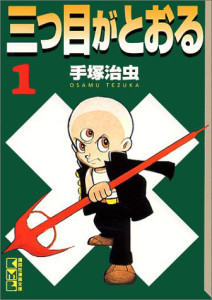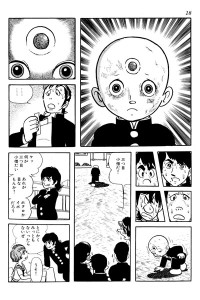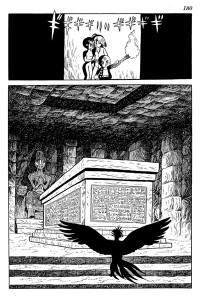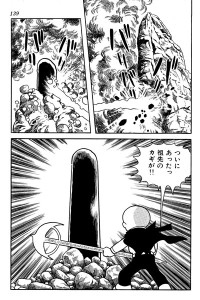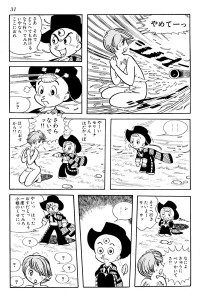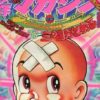Three-Eyed One, The (Manga)
Also known as 三つ目がとおる (Mittsume ga Toru)
| English Title: | The Three-Eyed One |
| In English? | No |
| Japanese Title: | 三つ目がとおる [Mittsume ga Toru] |
| Type: | Ongoing Serial |
| Original run: | 1974/07/07 – 1978/03/19 |
| Published in: | Weekly Shonen Magazine [週刊少年マガジン] |
| Published by: | Kodansha |
| Volumes: | 13 (MT-101 | MT-102 MT-103 | MT-104 MT-105 | MT-106 MT-107 | MT-108 MT-109 | MT-110 MT-111 | MT-112 MT-113) |
The Three-Eyed One (1974-78) is, after Astro Boy (1952-68), Tezuka’s most popular shonen (young boy) adventure story. Originally published in Weekly Shonen Magazine from July 1974 to March 1978, the manga series has also spawned an animated TV Special in 1985, as well as a 48-episode animated television series that aired from October 1990 to September 1991.
What it’s about
Sharaku Hosuke is not your typical, shy middle-school student. He was adopted as an infant by Dr. Kenmochi, who discovered Sharaku‘s third eye and sinister genius when the boy was about 7 years old. Placing an x-shaped bandage on his forehead to cover the third eye, Dr. Kenmochi warns Sharaku not to remove it. Heeding his foster father, Sharaku does not really understand what would happen if he were to take it off… just that it would be very bad. And so, with the bandage in place, Sharaku is infant-like in appearance, constantly harassed by his classmates, untalented in the classroom, poor at athletics, and generally lonely and afraid. Although a little mischievous, he is usually at his happiest when he can escape his own age group and play with toddlers on the playground.
However, if the x-shaped bandage on his forehead is removed, it reveals his third eye, which, when opened, unseals the hidden power of the Three-Eyed Ones – an ancient race of powerful, magical demons, of whom Sharaku is the last descendant. With his powers unsealed, Sharaku is transformed into a crafty, malicious trickster. He is a powerful magician, with hypnotic and telekinetic powers, as well as ancient spells at his command. Even more dangerous than his powers is his malicious cunning – given just a few minutes he can cobble together common garbage to create terrifying machines capable of drawing destructive energy from the very fabric of the cosmos.
And so, in order to learn about his roots, Sharaku, along with is friend and keeper, the beautiful but tomboyish female classmate, Wato Chiyoko, investigate the ruins of the long-lost civilization of the Three-Eyed Ones. Despite being in the thrall of Sharaku‘s charisma, Wato is hardly a passive partner. She is curious and somewhat selfish, enjoying the good and bad elements of Sharaku‘s adventures, and often leading him into trouble. Wato is also very beautiful, and is often approached by men trying to take advantage of her or distract her from Sharaku. Rather than relying on Sharaku to fight them off, she usually does it herself, often with a large hunk of wood, or with her own martial arts. Even though Sharaku seems much younger than Wato – due to his childlike form – they are in the same class in school, yet the romance which develops between them is a strange one. As a boy Sharaku is simply too meek to disobey Wato when she bosses him around, yes as the Three-Eyed One, he often states his intention to spare her when he conquers her miserable species – which, for him, is a sign of great affection.
Throughout their world-wide search, which takes them to such exotic locals as Arizona, Easter Island, and Mexico (among others), Sharaku must decipher ancient scriptures and artifacts, usually with the help of gadgets he creates to get him out of (and sometimes in to) trouble.
The manga story line is serial, with several separate adventures, some long, some short. Many of the stories inevitably involve the bandage being removed either by accident, by some foolish person harassing him, by a criminal or scientist trying to exploit him, or by Wato herself in case of mortal danger. Even though the Three-Eyed One within Sharaku is bent on conquering humanity, his adventures often do not involve this primary purpose, as he is distracted by the other strange mysteries he and Wato encounter. Throughout it all, scientists and anthropologists who have heard of Sharaku attempt to use him to investigate the ancient Three-Eyed race. Though they seem to have left their legacy in ancient pyramids and ruins around the globe, the scientists are unsure as to whether they were mutated humans, aliens, or something else entirely.
What you should know
The Three-Eyed One (1974-78) was, in part, inspired by the novel The Path of Fire which was written by Matsumoto Seicho and serialized in the Asahi Shimbun newspaper from June 16 1973 to October 13 1974. It is also generally illustrative of the Japanese public’s interest, at the time, in supernatural powers, lost ancient civilizations, and the occult – which, incidentally, also spawned (albeit in a very different way) Tezuka’s manga series Barbara (1973-74).
In The Three-Eyed One (1974-78), we can clearly see Tezuka’s own interest in the mysteries of ancient history, especially interpreted through the lens of science-fiction. In it we can see Tezuka’s tried and true message that, no matter how prosperous a civilization becomes, it will eventually fall victim to its own vanity. Also, like most of Tezuka’s children’s stories, the narrative touches on the question of whether of coexistence is possible between different sentient races. In this case the Three-Eyed Race is long since extinct, making the conflict less acute. However, Sharaku’s time traveling powers and the archaeological themes developed by uncovering the remnants of the ancient Three-Eyed civilization frequently bring the question to the fore.
Although non-Japanese readers may not be aware of it, the names of the two main protagonists, Sharaku Hosuke and Wato Chiyoko are, in fact, puns of Sherlock Holmes and Dr. Watson. Also, Tezuka himself mentions, in the Afterword of the Osamu Tezuka Complete Manga Works edition (MT-113), that the character design for Sharaku is based upon Elmer Fudd, the popular character from the Warner Bros. Looney Tunes animated series. This is interesting to note considering that it is widely believed that Sharaku was also derived from a make-believe alternate persona Tezuka himself used as a child – when he himself was shy, goofy-looking, harassed and teased.
Regardless, whether a childhood invention or a creation of adulthood, Sharaku is certainly a fantastic protagonist for this style of playful adventure literature, and his cunning, devilish, alternate persona makes his adventures dark enough to delight adults as well as children.
Sharaku is also yet another of Tezuka’s transforming creatures. Like Pook, the transforming robot in Astro Boy (1952-68), Melmo, the girl with the magic candy that lets her shift from child to adult in The Marvelous Melmo (1971-72), Sapphire, the gender-bending hero of Princess Knight [Nakayoshi] (1963-66), Toppei, the werewolf from Vampires (1966-69), and many others, Sharaku transforms from a weak-kneed boy to a powerful sorcerer simply by removing a bandage. In most of Tezuka’s later works, the pure-heart hero appears less and less and the tainted ones, who often straddle the line between good and evil, become the majority. In Sharaku we see a marriage of good and evil in one body; however, this is an evil of a different sort. Unlike the dark villainy of Makube Rokuro in Vampires (1966-69), Sharaku‘s evil side in The Three-Eyed One (1974-78) – written almost a decade later – is, in some sense, positive and playful.
Yet, despite Tezuka’s exploration of these complex themes, he never forgets his primary task as an entertainer. As such, The Three-Eyed One (1974-78) also incorporates some of the first “fan service” scenes in a Tezuka manga. Perhaps influenced by Go Nagai’s earlier, Harenchi Gakuen (1968-72), Sharaku‘s lovely companion Wato often seems to have extreme difficulty in keeping all her clothes on.
What else you should check out
Check out the links below for chapter summaries and more detailed publication information on The Three-Eyed One (1974-78) serialization in Weekly Shonen Magazine.

